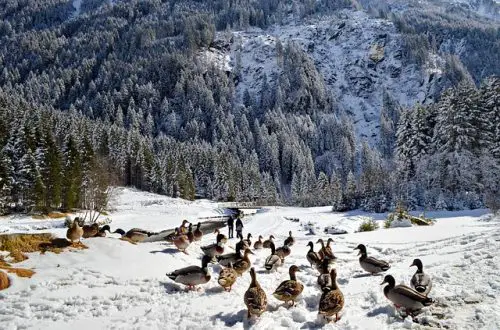The question – of how animals stay warm in the winter is frequently asked by many animal lovers. Winter is the coldest season among the four seasons, the others being spring, summer, and autumn. It is associated with icy temperatures and snow. This brings many changes and everyone has to find the means to adapt.
During this period of freezing temperatures, the goal is either to stay warm or risk losing body heat to cold and getting frostbite or hypothermia which can lead to death. Humans know what to do in times like this, they will layer up (putting on more clothes), drink hot tea or coffee, and light fires all in a bid to stay warm.

How Then Do Animals Stay Warm?
For pets at home, it is the responsibility of its owner to keep it warm. How about those out in the wild? Water for drinking and bathing gets frozen, and grasses and other food sources get covered with piles of snow. How do they cope?
There Are Majorly Three Coping Mechanisms Animals Employ To Stay Warm During Winter.
Migration (Move To A Different Environment)
Most animals, especially birds migrate to areas with warmer temperatures before the winter season. The icy temperature isn’t the only reason for migration, but the inability to find food. Trees lose their leaves, and grasses and other substances animals feed on are covered with snow.
Once surviving becomes difficult for them, they migrate. Examples of migrating animals are bats, caribou, elk, and humpback whales. Even insects, monarch butterflies, and moths migrate. Not all animals migrate. Some, however, find other ways to stay warm in winter.
Hibernation (Slow Metabolism And Energy Conservation Through Rest Or Sleep)
Hibernation is a special form of deep sleep animals goes into for some part of the winter period or all of it to save energy. They need little or no food during hibernation. Animals build a den or burrow into the soil to sleep. When in hibernation their body temperature drops down, breathing and heart rate becomes slow.

You must be wondering how an animal will be in a deep sleep all through winter and still survive it. They always prepare for hibernation by eating enough food during the time of abundance and storing it as body fat. Other hibernators store food in their burrows and dens to eat whenever they wake, then go back to sleep.
The body fat they store is used as energy while hibernating. Animals who only sleep for some part of winter store foods before winter and wake up occasionally to eat then go back to sleep. Raccoons and skunks are light hibernators (light sleepers) and are easily awakened.
Grizzly bears are heavy hibernators (heavy sleepers) and possess very unique traits unlike other hibernators, they can hibernate for as long as six months without drinking, eating or excreting. Though it is said that most bears like the black bears recycle their pee.
Nitrogen is a major component of urine and it is reabsorbed into the liver where the amino acids that are formed for skeletal muscle are resynthesized. The black bear ends up losing little or no muscle mass after hibernation. Examples of other animals that hibernate are the eastern chipmunk, fish, frog, snake, jumping mouse, turtle, groundhog, and some bats.
Adaptation (Change In Physical Features And Behavior)
Most animals are more active no matter how chilly the temperature is. This is because they are able to adapt to the environment quickly. Animals like rodents, foxes, squirrels mice, and beavers are very active in winter, they gather extra food in the fall and store it to eat later.
The ways in which they adapt differ across animals and species. Some make changes in their behavior or bodies, and some change their diets and eat other kinds of food. Red fox adapts by eating different types of food.

Some other examples of how animals adapt through winter:
- Animals change their fur color to blend into the snow.
- Some animals develop layers of fat by eating great amounts of food for warmth.
- Animals huddle together and share body heat. Even those that normally don’t live together come together for warmth.
Migration, hibernation, and adaptation are general coping mechanisms.
Let’s Be More Specific And See The Different Ways, different Animals Respond To Cold Winter.
Polar bears can withstand very harsh, chilly temperatures. They have thick, translucent white hollow hairs that trap light to maintain warmth. This helps them to blend with the environment. The thick white fur traps a layer of air to insulate and keep them warm. The fur also protects them from icy waters because of how oily it is.
Musk Oxen live in Arctic Canada. They have an insulating undercoat that helps them withstand frigid winter conditions. They have sharp hooves for digging into ice and snow for food. Their long, curved horns are used for defense against predators. They travel in groups, staying close to each other to stay warm.
Squirrels collect nuts and keep them while waiting for winter. These nuts will serve the necessary energy when food is scarce. Mice and beavers store foods in their holes so that when winter comes, they are not found wanting.
Snakes, lizards, and most fishes are ectothermic [1], which means their body temperature remains the same as the environment. During winter when the temperature is cold, their metabolism slows down
Chipmunk does some pretty amazing things. They can collect thousands of food items like nuts and bury them in separate places, they go into semi-hibernation and emerge once in a while to feed on the various places they buried their foods, eat and get energy for their body to generate heat which in turn keeps them warm.
Seeing the different ways animals prepare before winter and stay through it to keep warm is really amazing. Migration from a standpoint seems more like an escape from winter than surviving through it. The only animals that can be said to keep warm and survive through winter are the ones who hibernate and adapt.
Glossary
- Britannica [Link]




